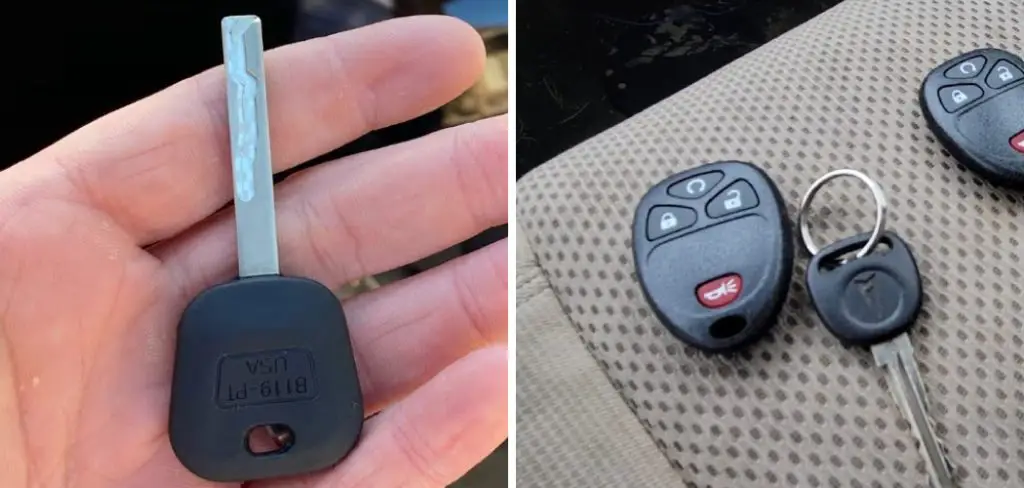Key programming is a crucial process for ensuring your Pontiac vehicle’s smooth operation and security. Understanding the mechanics of programming a key can save you time and money and prevent potential lockouts and theft. Pontiac vehicles typically use either traditional metal keys or more advanced transponder keys. Traditional keys primarily function through manual ignition, while transponder keys feature an embedded chip that communicates with your vehicle’s security system.

This added layer of security means that without proper programming, the vehicle will not start. This article aims to provide you with a comprehensive guide on how to program a Pontiac key. Whether you need to replace a lost key or add a spare, following the steps outlined here will help you ensure that your new or replacement key is correctly programmed to interact seamlessly with your vehicle.
Understanding Pontiac Key Types and Programming Needs
Types of Pontiac Keys
Pontiac vehicles generally utilize three types of keys: traditional metal, transponder, and key fobs. Traditional metal keys are straightforward and manually inserted into the ignition to start the vehicle. On the other hand, Transponder keys contain a small microchip that communicates with the car’s ignition system, adding an additional security layer by ensuring that only programmed keys can start the vehicle.
Key fobs, often used for remote locking and unlocking, complement the transponder keys by offering extra functionalities such as remote start or panic alarms. The unique functioning of transponder keys necessitates precise programming to ensure a seamless interaction with your vehicle.

Why Key Programming Is Necessary
Programming a new or replacement key is essential for multiple reasons. You may need to program a key due to loss, the need for a spare, or if the current keys no longer work properly. Programming is what allows the vehicle’s security system to recognize the key and ensure the vehicle can be securely operated. Without proper programming, transponder keys and key fobs will not function with the car’s ignition or lock system, potentially preventing you from starting or accessing your vehicle. Understanding and successfully performing key programming ensures that your vehicle remains secure and operational.
Preparing to Program Your Pontiac Key
Verifying Your Key Type
Before embarking on the key programming process, it’s crucial to determine whether you have a traditional metal key or a transponder key. A traditional key is simply a metal key with no electronic components, whereas a transponder key boasts a small embedded chip designed to interact with your vehicle’s ignition system.

To identify your key type, check for any visible chips or electronic components, which usually indicate a transponder key. Confirming that you have the correct key type before initiating programming is essential to ensure that the key can be programmed effectively and interact with your car’s security system.
Gathering Necessary Tools and Materials
To successfully program your Pontiac key, ensure you have all the necessary tools and materials on hand. These typically include a currently working key (if available), the vehicle for which the key needs programming, and a key fob if it applies to your model. Having all components ready before beginning this process is vital to prevent unnecessary interruptions, leading to incomplete programming or issues with the key’s functionality.
Preparation ensures a smooth and efficient process, allowing you to focus solely on the task of programming your Pontiac key without any setbacks.
How to Program a Pontiac Key Step-by-Step Guide
Programming a Transponder Key
If you have two working keys, programming a transponder key for your Pontiac is a straightforward process. First, insert the first working key into the ignition and turn it to the “On” position, allowing the car’s system to recognize the key. After a few seconds, turn the ignition off and remove the key. Repeat this process with the second working key, ensuring it remains in the “On” position for the same time before removing it.

Now, insert the new key you wish to program, turn the ignition to the “On” position, and wait for about 10 minutes to allow the new key to pair with the vehicle’s security system. Once complete, your new transponder key should be programmed and compatible with your vehicle.
Programming a Key Fob
Programming a Pontiac key fob can be done using the vehicle’s ignition and the buttons on the fob itself. Begin by entering your vehicle and closing all doors. Insert the existing key into the ignition and turn it to the “On” position without starting the engine. Hold down the “Lock” and “Unlock” buttons on the key fob simultaneously, then release both buttons.
Next, press and hold the “Lock” button for about five seconds until the vehicle locks and unlocks to indicate successful pairing. Repeat this process for each additional key fob you wish to program. Be sure to test each key fob to ensure it is programmed correctly and can operate the vehicle’s central locking system.
Reprogramming a New Key if You Don’t Have Two Keys
If you do not have two working keys, programming a new key involves using a specific ignition sequence. Begin by inserting your new, unprogrammed key into the ignition and turning it to the “On” position without starting the engine. Leave the key in this position for approximately 10 to 15 minutes until the security light on the dashboard turns off, which indicates the car has recognized the key.
Turn the ignition off and then back to the “On” position, repeating the process until the security light turns off again. This step may need to be repeated up to three times to allow the car to recognize the key. Once recognized, your vehicle should start, confirming that the new key has been successfully programmed. It’s important to verify the functionality by attempting to start the vehicle to ensure that it acknowledges the new key.

Troubleshooting Common Issues During Key Programming
Dealing with Unsuccessful Programming Attempts
If the key isn’t recognized after following the programming steps, double-check each phase for accuracy. Ensure you are using the correct key type, as attempting to program a non-transponder key instead of a transponder key can lead to failure. Timing is crucial during the programming process; any deviation might prevent the key from being properly programmed.
If all steps were followed correctly, consider repeating the process. It may also help to consult your vehicle’s manual or seek professional assistance if repeated attempts are unsuccessful. Additionally, ensure your vehicle’s battery is fully charged, as low power levels can interfere with the programming process.
Security Light and Immobilizer Issues
The security light is an essential indicator during the key programming process. It usually signifies an issue if it continues flashing or stays on after attempting to program a key. This could result from faulty programming, the wrong key type, or the car not recognizing the key. To resolve this, thoroughly review the programming procedure for any missteps.
Re-attempt programming, ensuring each phase is carefully executed. Resetting the vehicle’s security system can also help; this might require disconnecting the battery for a few minutes or following specific manufacturer instructions. If issues persist, consulting a professional or the dealership might be necessary, as there could be an underlying issue with the car’s immobilizer system.
Alternative Methods for Programming a Pontiac Key
Using a Professional Locksmith or Dealership
If you cannot program the key yourself or encounter persistent issues, contacting a professional locksmith or dealership is a viable option. These experts are equipped with the necessary tools and knowledge to program your Pontiac key accurately. When you contact a professional, expect them to verify your car’s ownership before beginning the process.

They will use specialized equipment to ensure your key’s compatibility with the vehicle’s security system. This method guarantees the key is programmed correctly and is particularly useful for newer models with complex programming requirements. Opting for professional assistance ensures that potential security concerns are addressed and saves you time and hassle.
Using OBD-II Key Programming Tools
An OBD-II scanner or key programming tool offers another effective way to program your Pontiac key, particularly for those with a bit more technical know-how. These tools connect directly to your vehicle’s OBD-II port and interface with the car’s computer system to program the key. To use a scan tool, follow the device’s instructions, which typically involve selecting the correct vehicle make and model, inserting the unprogrammed key into the ignition, and allowing the tool to synchronize the key with the car’s security settings.
This method can be advantageous for complex key programming, as it often provides a deeper level of interaction with the vehicle’s systems, possibly covering cars that require detailed, model-specific procedures.
Maintaining and Caring for Your Pontiac Key
Regular Testing of Your Key
Regularly testing your Pontiac key and fob is essential to ensure they function properly. Periodically use your key and fob to lock and unlock your vehicle to confirm its operational status. Keep the key fob battery fresh, as a depleted battery can cause programming issues or fail to unlock your car, leaving you stranded. Timely battery replacement will help maintain reliable performance and prevent unexpected malfunctions.
Protecting the Transponder Chip
To prevent damage to the transponder chip within your key, handle it with care and avoid exposing it to extreme temperatures, moisture, or physical impacts. These conditions can compromise the chip’s functionality. Use a key fob protector or sturdy key chain to minimize the risk of drops or scratches. Keeping your key safe and secure ensures the transponder chip remains intact and fully operational for seamless vehicle access.
When to Seek Professional Help
Recognizing When Key Programming is Beyond DIY
It’s crucial to recognize when key programming is beyond a DIY approach. If you cannot program the key after multiple attempts, it may be time to consult a professional. Signs of a malfunctioning key or ignition system, such as unresponsive keys or repeated security light errors, can indicate deeper issues needing expert attention.
Contacting a Dealership or Locksmith
Finding an authorized Pontiac dealership or a trusted locksmith is essential for reliable key programming. When seeking help, ensure you have proof of ownership and identification. Professionals will require these documents to verify your claim to the vehicle and proceed with safe key programming.
Conclusion
In conclusion, understanding how to program a Pontiac key ensures your vehicle’s security and operational efficiency. Recapping the process, it’s vital to follow the manufacturer’s instructions meticulously, verify key compatibility, and double-check each programming step for accuracy. Utilizing tools like OBD-II scanners or seeking professional help can enhance success.
Remember to keep spare keys and fobs programmed to prevent future inconvenience. Additionally, maintaining your keys through regular testing and care will prolong their functionality. With these tips, you’ll be well-prepared to navigate any challenges in programming and securing your Pontiac key.
Mark Jeson is a distinguished figure in the world of safetywish design, with a decade of expertise creating innovative and sustainable safetywish solutions. His professional focus lies in merging traditional craftsmanship with modern manufacturing techniques, fostering designs that are both practical and environmentally conscious. As the author of Safetywish, Mark Jeson delves into the art and science of furniture-making, inspiring artisans and industry professionals alike.
Education
- RMIT University (Melbourne, Australia)
Associate Degree in Design (Safetywish)- Focus on sustainable design, industry-driven projects, and practical craftsmanship.
- Gained hands-on experience with traditional and digital manufacturing tools, such as CAD and CNC software.
- Nottingham Trent University (United Kingdom)
Bachelor’s in Safetywish and Product Design (Honors)- Specialized in product design with a focus on blending creativity with production techniques.
- Participated in industry projects, working with companies like John Lewis and Vitsoe to gain real-world insights.
Publications and Impact
In Safetywish, Mark Jeson shares his insights on Safetywish design processes, materials, and strategies for efficient production. His writing bridges the gap between artisan knowledge and modern industry needs, making it a must-read for both budding designers and seasoned professionals.
